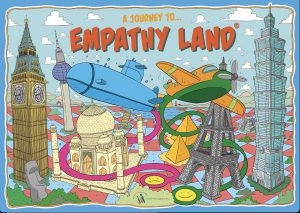
Welcome to your journey to Empathy Land! This is a fun game that will help you discuss habits at home that may be culturally driven or just family habits. The purpose of the game is to generate an intercultural dialogue between families, friends, neighbours and colleagues. Of course, within your own family, the game can also be played without the cards. However, it is also fun to imagine the habits of friends or neighbours when you draw a card. Whomever reaches Empathy Land first wins. During the journey it is fun to discuss the landmarks you pass. You may have visited some and others you may want to put on the bucket list. Who wants to go where? With smaller children you can neglect the cards and just focus on the landmarks.
In its original version, Empathy Land is an interactive board game played by three to six players. Through sharing habits and guessing whether these are true or false, the players gain awareness and understanding about each others’ at-home habits.
Insights
- Players develop awareness and understanding of differences and similarities in the cultural or family habits and values of the other players.
- Players gain insight into differences, subcultures and gray areas.
- Players realize that habits and behavior are often an expression of deeper cultural values.
Players: 3 – 6 players per game board
Duration: ~ 25 minutes
Materials
- The game board
- A set of storytelling cards
- 6 true/false voting cards
- One die
- Tokens for each player
- Blank A4 papers (one per group, cut into pieces per player)
- Pen / Pencil
Step 1: Preparation
- Take the blank A4 papers and cut them into 4 or 6 pieces depending on the amount of players. Make sure each player has one piece of paper and writes “True” on one side and “False” on the other.
Step 2: Instructions
The aim of the game is to get to know each other better and to discuss differences in usage and habits. Differences that may just be there and which are fun and useful to know of each other.
Draw:
- The game begins with one player (“the storyteller”) picking a card.
Read:
- The storyteller reads the card out loud to the group.
Guess:
- The other players guess if this statement is “True” or “False” for the home life of the storyteller by holding up their “True” or “False” cards.
Reveal:
- Once everyone has voted, the storyteller reveals the answer.
Rolling the die and point system:
- The player(s) that answered correctly get to roll the die and move that many spaces, clockwise around the board.
- The player(s) that answered incorrectly doesn’t get to roll the die.
- The storyteller always gets to roll the die regardless of correct/incorrect guesses, unless no players guess correctly, in which case the storyteller gets to pick another card and the other players vote again.
Moving around the gameboard:
- If a player lands on a space with an airplane, the player gets to jump forward to the indicated space.
- If a player lands on a space with a submarine, the player has to go back to the indicated space.
- The choice to end the game through precise arrival on #50 or through surpassing #50 is up to you and your fellow players!
Alternatives:
- It is also possible to play Empathy Land without the storytelling cards. In this case, every player has to come up with a statement by themselves during their turn. Afterwards, the other players have to guess if this is true or false for the storyteller.
- Further, it is possible to play without the “True” and “False” cards. Instead, every player can show, simultaneously a “thumbs up” or “thumbs down” to vote.
Step 3: Optional Discussion after the gameplay
- If the players want to link the habits described on the game cards to a conversation about the basic differences between cultures, they should read about the Social Dilemma Themes of our cultural framework. We have also provided a list of discussion questions at the end of this document for those who want to take full advantage of the learning insights of this game.Possible questions:
- What did you notice?
- Are there things that have surprised you?
- Where were the differences?
- How do things go at times when people want to do things differently than the majority?
- Did everyone feel comfortable saying how he / she is doing at home?
- How would you respond if you were in the minority?
- What do you think of those differences?
- Where do you think the differences come from? (male / female relationships; division of labor at home; hygiene rules; differences in religion; obedience and discipline etc.)

